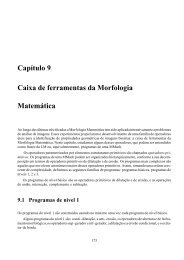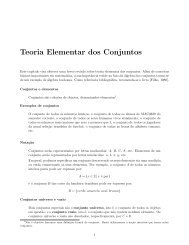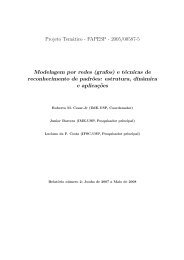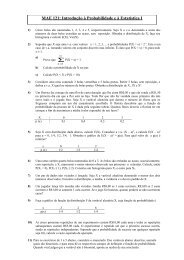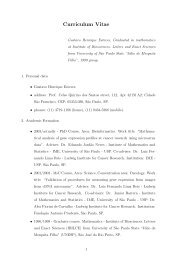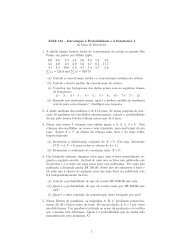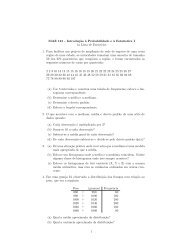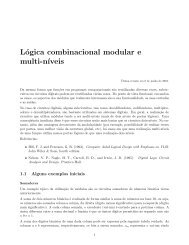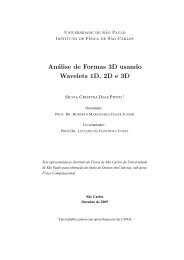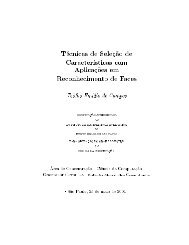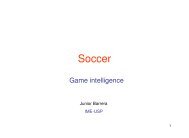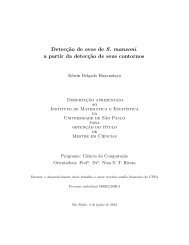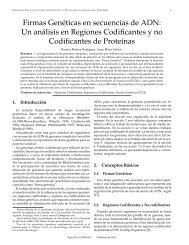X - Vision at IME-USP
X - Vision at IME-USP
X - Vision at IME-USP
Create successful ePaper yourself
Turn your PDF publications into a flip-book with our unique Google optimized e-Paper software.
Design of Morphological<br />
Oper<strong>at</strong>ors by Learning<br />
Junior Barrera<br />
jb@ime.usp.br<br />
<strong>IME</strong>-<strong>USP</strong>
Layout<br />
Introduction<br />
Binary oper<strong>at</strong>or design: W-oper<strong>at</strong>ors W<br />
Binary oper<strong>at</strong>or design: constraint W-W<br />
oper<strong>at</strong>ors<br />
Gray-scale oper<strong>at</strong>or design: apertures<br />
Gray-scale oper<strong>at</strong>or design: stack filters<br />
Conclusion<br />
2
Introduction
Morphological Machine (MMach)<br />
d e A A n<br />
i Ÿ ne<br />
Ÿ ⁄ ∏<br />
A<br />
4
Properties<br />
Any finite l<strong>at</strong>tice oper<strong>at</strong>or can be<br />
implemented as a program of a MMach<br />
Finite l<strong>at</strong>tices of practical importance are the<br />
l<strong>at</strong>tice of binary and gray-scale images<br />
5
Morphological Toolbox<br />
Library of hierarchical functions:<br />
- primitives: : elementary oper<strong>at</strong>ors and<br />
oper<strong>at</strong>ions;<br />
- high order oper<strong>at</strong>ors: : primitives and high<br />
order oper<strong>at</strong>ors<br />
6
Heuristic Design<br />
Divide the problem in subproblems<br />
Each subproblem is solved by a toolbox<br />
function<br />
Integr<strong>at</strong>e the subproblems solution<br />
7
Autom<strong>at</strong>ic Design<br />
Oper<strong>at</strong>or learning in a standard<br />
represent<strong>at</strong>ion<br />
Finding an equivalent and more efficient<br />
represent<strong>at</strong>ion<br />
8
Oper<strong>at</strong>or Design<br />
9
Applic<strong>at</strong>ion<br />
10
Change of Represent<strong>at</strong>ion<br />
e ⁄ e<br />
⁄ Ä Ä Ä ⁄ e<br />
A 1 A 2 A n<br />
y<br />
Oper<strong>at</strong>ors<br />
d A e A<br />
Phrases<br />
11
Oper<strong>at</strong>or Design
The problem<br />
observed<br />
ideal<br />
Find an image oper<strong>at</strong>or th<strong>at</strong> transforms the observed<br />
image to the respective ideal (or “close to the ideal”)<br />
image.<br />
13
Binary image oper<strong>at</strong>ors<br />
Binary image :<br />
Binary images can be understood as sets :<br />
is a complete Boolean l<strong>at</strong>tice<br />
Binary image oper<strong>at</strong>ors = set oper<strong>at</strong>ors :<br />
14
Transl<strong>at</strong>ion invariance<br />
Transl<strong>at</strong>ion of S by z :<br />
is<br />
transl<strong>at</strong>ion-invariant iff<br />
15
Local definition<br />
Window :<br />
An image oper<strong>at</strong>or is locally defined within iff<br />
16
W-oper<strong>at</strong>ors<br />
Transl<strong>at</strong>ion invariance<br />
+<br />
local definition within<br />
=<br />
-oper<strong>at</strong>ors<br />
z<br />
W-oper<strong>at</strong>ors are characterized by Boolean functions.<br />
17
Window<br />
Represent<strong>at</strong>ion<br />
1<br />
1<br />
1<br />
1<br />
X11 1X0 11X<br />
18
St<strong>at</strong>istical Hypothesis<br />
X and Y are jointly st<strong>at</strong>ionary<br />
P( S ∩Wz,<br />
Y<br />
)<br />
is the same for any z in E<br />
19
St<strong>at</strong>ionary Process<br />
20
Join St<strong>at</strong>ionary Process<br />
21
Error measure<br />
Design goal is to find a function<br />
with minimum risk.<br />
Risk (expected loss) of a function :<br />
Loss function<br />
X is a random set<br />
Y is a binary random variable<br />
22
MAE example<br />
Example : MAE loss function<br />
Optimal MAE function<br />
ψ ( X<br />
)<br />
=<br />
⎧<br />
⎨<br />
⎩<br />
1<br />
0<br />
p (1,<br />
p (1,<br />
X )<br />
X )<br />
><br />
≤<br />
p (0,<br />
p (0,<br />
X )<br />
X )<br />
23
Design procedure<br />
24
PAC learning<br />
L is Probably Approxim<strong>at</strong>ely Correct (PAC)<br />
For m > m( ε,<br />
δ ) examples<br />
Pr(|<br />
R(<br />
ψ<br />
)<br />
− R(<br />
ψ ) | < ε)<br />
> 1<br />
opt<br />
−<br />
δ<br />
ε,<br />
δ ∈ (0,1)<br />
25
Edge detection<br />
Training images<br />
Test images<br />
26
Noise filtering<br />
Training images<br />
Test images<br />
27
Texture extraction (1)<br />
Training images<br />
28
Texture extraction (2)<br />
Test images<br />
29
Fracture Detection<br />
Training images<br />
Test images<br />
30
Amount of d<strong>at</strong>a available<br />
18,10 %<br />
3,13 %<br />
2,68 %<br />
2,21 %<br />
Last Image<br />
2,01 %<br />
1,82 %<br />
1,69 % 1,60 %<br />
Noise 1 image 2 images 3 images 8 imagess 13 images 25 images 32 images<br />
31
window 5x5, 6 training images<br />
addition: 2%<br />
subtraction: 1%<br />
distict p<strong>at</strong>terns : 140.060<br />
in 1.548.384<br />
addition: 3%<br />
subtraction: 3%<br />
distinct p<strong>at</strong>terns : 266.743<br />
em 1.548.384<br />
addition: 6%<br />
subtraction: 6%<br />
distinct p<strong>at</strong>terns: 487.494<br />
in 1.548.384<br />
32
Size of the window<br />
Error r<strong>at</strong>e in function of window size<br />
0.70%<br />
0.60%<br />
0.50%<br />
0.40%<br />
0.30%<br />
0.20%<br />
0.10%<br />
0.00%<br />
3x3 4x4 5x5 6x6 7x7<br />
1<br />
2<br />
3<br />
4<br />
5<br />
6<br />
7<br />
8<br />
33
Constraint Design
Constraints<br />
ψ opt<br />
Ψ<br />
35
Constraints<br />
ε des<br />
ε des-con<br />
Error<br />
ε opt-con<br />
ε opt<br />
N 1 N 0<br />
N 2<br />
Sample size<br />
36
Constraints<br />
Structural Constraints<br />
- impose maximum number of elements in the basis<br />
- use altern<strong>at</strong>ive structural represent<strong>at</strong>ions<br />
(e.g., sequential)<br />
37
Constraints<br />
Algebraic constraints<br />
- consider a class of oper<strong>at</strong>ors s<strong>at</strong>isfying a given<br />
algebraic property (e.g., increasingness ,<br />
idempotence, auto-dualism, etc)<br />
- consider a constraint by a multi-resolution criteria<br />
- consider a constraint by an envelope of oper<strong>at</strong>ors<br />
- consider a constraint by a multi-resolution envelope<br />
criteria<br />
38
Structural Constraint
Minimum number of intervals<br />
in the basis
Iter<strong>at</strong>ive design
Motiv<strong>at</strong>ion : composition of oper<strong>at</strong>ors over small<br />
windows produces an oper<strong>at</strong>or over a larger window<br />
is a<br />
-oper<strong>at</strong>or<br />
45
Applic<strong>at</strong>ion example<br />
test image<br />
iter<strong>at</strong>ion 1<br />
iter<strong>at</strong>ion 2<br />
46
Applic<strong>at</strong>ion example<br />
test image iter<strong>at</strong>ion 1<br />
iter<strong>at</strong>ion 2 iter<strong>at</strong>ion 3<br />
iter<strong>at</strong>ion 4 iter<strong>at</strong>ion 5 iter<strong>at</strong>ion 6<br />
47
Algebraic Constraint
Increasing W-oper<strong>at</strong>ors<br />
increasing<br />
non-increasing<br />
49
Design of increasing W-oper<strong>at</strong>ors<br />
increasing<br />
non-increasing<br />
increasing<br />
50
Multi-resolution constraint
x 1 x 2 x 3 x 4 x 5 x 6 x 7 x 8<br />
8 variables<br />
z 1 z 2 z 3 z 4<br />
4 variables<br />
w 1 w 2 2 variables<br />
0<br />
1<br />
0 1<br />
00<br />
01<br />
10<br />
11<br />
0<br />
0<br />
0<br />
1<br />
1<br />
0<br />
1<br />
1<br />
0000<br />
0001<br />
0010<br />
0011<br />
0100<br />
0101<br />
0110<br />
0111<br />
1000<br />
1001<br />
1010<br />
1011<br />
1100<br />
1101<br />
1110<br />
1111<br />
0<br />
0<br />
0<br />
0<br />
0<br />
0<br />
0<br />
1<br />
0<br />
0<br />
1<br />
0<br />
0<br />
0<br />
1<br />
1<br />
0<br />
1<br />
0<br />
0<br />
0<br />
1<br />
0<br />
1<br />
0<br />
1<br />
1<br />
0<br />
0<br />
1<br />
1<br />
1<br />
1<br />
0<br />
0<br />
0<br />
1<br />
0<br />
0<br />
1<br />
1<br />
0<br />
1<br />
0<br />
1<br />
0<br />
1<br />
1<br />
1<br />
1<br />
0<br />
0<br />
1<br />
1<br />
0<br />
1<br />
1<br />
1<br />
1<br />
0<br />
1<br />
1<br />
1<br />
1<br />
2 variables: 2 2 =4 4 variables: 2 4 =16<br />
8 variables: 2 8 =256 53
W 0<br />
W 1<br />
D 1 = P(W 1 )<br />
D 0 = P(W 0 )<br />
z i = p i (x i1 , ... , x i9 ) , z = p(x) , p=(p 1 , .. p 9 )<br />
Let φ:D 1 →{0,1} , it defines the oper<strong>at</strong>or Ψ φ on D o by<br />
Ψ φ (x) = φ(p(x))<br />
The operador Ψ φ is constrained by resolution to D 1<br />
Equivalence classes defined<br />
by<br />
p(x) = p(y)<br />
D 0<br />
54
Properties<br />
Q<br />
Ψ φ<br />
φ<br />
Oper<strong>at</strong>ors over D 1<br />
Oper<strong>at</strong>ors over D 0 constrained by resolution on D 1<br />
Oper<strong>at</strong>ors over D 0<br />
55
D 2<br />
= P(W 2<br />
), D 1<br />
= P(W 1<br />
), D 0<br />
= P(W 0<br />
)<br />
W x ∈D 0<br />
, z ∈D 1<br />
, v ∈D 2<br />
,<br />
0<br />
z i<br />
= p i<br />
(x i,1<br />
, ... , x i,9<br />
) , z = p(x) ,<br />
p=(p 1<br />
, .. p 81<br />
)<br />
v i<br />
= w i<br />
(x i,1<br />
, ... , x i,81<br />
) , v = w(x) ,<br />
p<br />
W 1 w=(w 1<br />
, .. w 9<br />
)<br />
W 2<br />
w The equivalence classes defined by<br />
p may be different by the ones<br />
defined by w.<br />
56
ψ ( x)<br />
=<br />
⎧ ψ0,<br />
N<br />
( x) if<br />
N( x)<br />
> 0<br />
⎪<br />
ψ<br />
,<br />
( x) ( x) = , ( ρ ( x))<br />
><br />
1 N<br />
if N 0 N<br />
1<br />
0<br />
⎪<br />
⎨ M<br />
⎪ψ m−1,<br />
N<br />
( x) if N( x) = 0,..., N( ρm−2( x)) = 0, N( ρm−<br />
1( x))<br />
> 0<br />
⎪<br />
⎩⎪<br />
ψ<br />
m,<br />
N<br />
( x) if N( x) = 0,..., N( ρm−<br />
1( x)) = 0, N( ρm( x))<br />
> 0<br />
57
Multiresolution Noise<br />
image noise image + noise<br />
61
3x3 window<br />
Pyramid<br />
Restaur<strong>at</strong>ion<br />
Persisting noise<br />
62
Example<br />
Hybrid Multiresolution Filter: Experiment I<br />
0.14<br />
0.12<br />
W 11<br />
W 10<br />
W 9<br />
W 8<br />
0.1<br />
W 7<br />
W 6<br />
W 5<br />
W 4<br />
0.08<br />
W 3<br />
W 2<br />
W 1<br />
W 0<br />
MAE<br />
0.06<br />
0.04<br />
0.02<br />
0<br />
Ψ11 Ψ10 Ψ9 Ψ8 Ψ7 Ψ6 Ψ5 Ψ4 Ψ3 Ψ2 Ψ1 Ψ0<br />
Window sequence<br />
Single oper<strong>at</strong>or<br />
Pyramid oper<strong>at</strong>or<br />
64
Envelope constraint
Independent Constraints<br />
Constraints<br />
Independent Constraint<br />
Restriction of<br />
the oper<strong>at</strong>ors space<br />
K(ψ opt ) ∈ Q ⊆ P(P(W)) (W))<br />
Let be A,BA<br />
⊆ P(W) with A⊆B:<br />
h ψ (x)=1 ∀ x∈A<br />
∀ψ<br />
& h ψ (x)=0∀x∉B,<br />
∀ψ :K(ψ) ∈Q<br />
P(P(W))<br />
K(ψ opt<br />
)<br />
{1}<br />
B<br />
Q<br />
A<br />
{0,1}<br />
Q<br />
B<br />
P(W)<br />
{0}<br />
P(P(W))<br />
A<br />
66
Independent Constraints<br />
Proposition: : if Q is an independent restriction then exist a par of<br />
oper<strong>at</strong>ors<br />
(α,β)) such th<strong>at</strong>, for any ψ∈Ψ W<br />
K(ψ) ∈Q ⇔ α≤ ψ ≤β<br />
where K(α) ) = A and K(β) ) = B<br />
• All independent constraint is characterized by two oper<strong>at</strong>ors α and<br />
β<br />
• The pair (α,β)(<br />
) is called “Envelope”<br />
h α<br />
{1}<br />
h β<br />
{1}<br />
A<br />
{0}<br />
A<br />
{1}<br />
B<br />
{0}<br />
B<br />
{0}<br />
P(W)<br />
P(W)<br />
67
Definition<br />
Desing of two heristic filters α and β such th<strong>at</strong> when we<br />
know th<strong>at</strong> α ≤ ψ opt ≤ β, the restriction is defined by:<br />
Q = {ψ : α ≤ ψ ≤ β}<br />
and any filter ψ can be projected into the restriction by<br />
ψenv = ( ψ ∨ α ) ∧ β<br />
68
Definition<br />
β<br />
Oper<strong>at</strong>ors over<br />
P(W)<br />
ψ<br />
ψ env<br />
Q<br />
α<br />
Oper<strong>at</strong>ors over P(W)<br />
constrained by envelope<br />
69
Properties<br />
♦ (ψ opt ∨ α ) ∧ β is optimal in Q.<br />
♦If α ≤ ψ opt ≤ β then Error[ψ env ] ≤ Error[ψ]<br />
♦If α ≤ ψ opt ≤ β is not true, then<br />
Lim N→∞ Error[ψ env,N ] > Lim N→∞ Error[ψ N ]<br />
70
Example<br />
71
Noise Edge Detection<br />
Ground<br />
Image<br />
Noise<br />
Addition<br />
Noisy Image<br />
Restor<strong>at</strong>ion<br />
Filtered<br />
Image<br />
Edge<br />
Detection<br />
Edge<br />
Detected<br />
Direct Edge Detection<br />
Edge Detected<br />
72
Restor<strong>at</strong>ion<br />
a) Machine design of the restor<strong>at</strong>ion<br />
ψ pac<br />
designed by examples<br />
b) Human-machine design of the restor<strong>at</strong>ion<br />
ψ con<br />
= (ψ pac ∩β) ∪ α<br />
α = δ B⊕B<br />
ε B⊕B<br />
δ B<br />
ε B and β = ε B⊕B<br />
δ B⊕B<br />
ε B<br />
δ B<br />
α and β are altern<strong>at</strong>ing sequential filters with<br />
P[ α(S) ≤ I ≤ β(S) ] ≈ 1<br />
B is the 3x3 square<br />
Machine design of<br />
the restor<strong>at</strong>ion<br />
Human-Machine<br />
design of the<br />
restor<strong>at</strong>ion<br />
0.28 % 0.13 %<br />
0,3<br />
0,25<br />
0,2<br />
0,15<br />
0,1<br />
0,05<br />
Machine design<br />
of the restor<strong>at</strong>ion<br />
Human design of<br />
the restor<strong>at</strong>ion<br />
0<br />
Error (%)<br />
73
Noise Edge Detection<br />
Edge<br />
Detection<br />
a) Machine design over noisy images<br />
ζ pac<br />
designed by examples from noisy images<br />
b) Human design after restor<strong>at</strong>ion<br />
ζ = I d<br />
- ε B<br />
B is the 3x3 square<br />
c) Machine design after restor<strong>at</strong>ion<br />
ζ pac<br />
designed by examples from restored images<br />
Machine<br />
design over<br />
noisy images<br />
Human<br />
design after<br />
restor<strong>at</strong>ion<br />
Machine<br />
design after<br />
restor<strong>at</strong>ion<br />
0.65 % 0.27 % 0.24 %<br />
0,7<br />
0,6<br />
0,5<br />
0,4<br />
0,3<br />
0,2<br />
0,1<br />
0<br />
Error (%)<br />
Machine design over<br />
noisy images<br />
Human design after<br />
restor<strong>at</strong>ion<br />
Machine design after<br />
restor<strong>at</strong>ion<br />
74
Noise Edge Detection<br />
Machine design over<br />
noisy images<br />
Error = 0.65%<br />
Human design after<br />
restor<strong>at</strong>ion<br />
Error = 0.27%<br />
Machine design after<br />
restor<strong>at</strong>ion<br />
Error = 0.24%<br />
75
Envelope multi-resolution<br />
constraint
Definition<br />
♦ W 1 ⊂ W 0 , ρ:D 0 → D 1 is a resolution mapping<br />
♦ α, β: D 1 → {0,1} with α ≤ β<br />
♦ ψ : D 0 → {0.1}<br />
ψ ρ<br />
( x)<br />
=<br />
⎧ 1<br />
⎪<br />
⎨ 0<br />
⎪<br />
⎩ψ<br />
( x)<br />
ifα(<br />
ρ(<br />
x))<br />
if β ( ρ(<br />
x))<br />
= 1<br />
= 0<br />
otherwhise<br />
♦ ψ ρ = (ψ ∧ β’) ∨ α’ , α’(x) = α(r(x)) and β’(x) = β(r(x))<br />
77
Definition<br />
Ψ φ<br />
β’<br />
φ<br />
β<br />
φ env<br />
ψ ρ<br />
Q<br />
α<br />
D 0<br />
α’<br />
D 1<br />
78
Teorema<br />
β’<br />
β<br />
φ<br />
ψ<br />
φ env<br />
ψ ρ<br />
α<br />
Q<br />
D<br />
α’<br />
1<br />
D 0<br />
79
Piramidal Design:<br />
Let ψ i,env,N = ( ψ i,N ∧ β’) ∨ α’, be the projection of the resolution<br />
constrained filter inside the envelope (α’, β’)<br />
ψ<br />
env−mres<br />
( x)<br />
=<br />
⎧ ψ0,<br />
N<br />
( x) if<br />
N( x)<br />
> 0<br />
⎪<br />
ψ<br />
env N<br />
if N = N ρ ><br />
1, ,<br />
( x) ( x) 0, (<br />
1( x))<br />
0<br />
⎪<br />
⎨ M<br />
⎪ψ m−1, env,<br />
N<br />
( x) if N( x) = 0,..., N( ρm−2( x)) = 0, N( ρm−<br />
1( x))<br />
> 0<br />
⎪<br />
⎩⎪<br />
ψ<br />
m, env,<br />
N<br />
( x) if N( x) = 0,..., N( ρm−<br />
1( x)) = 0, N( ρm( x))<br />
> 0<br />
80
Properties:<br />
♦ ψ env-mres is a consistent estim<strong>at</strong>or of ψ opt<br />
♦ If the envelope is well defined on D 1 , then the ρ-envelope of a<br />
resolution constrained filter is advantageous<br />
81
B<br />
E<br />
α = ε B (γ E φ E γ E )<br />
β = δ B (φ E γ E φ E )<br />
82
Gray-scale oper<strong>at</strong>or design:<br />
aperture
Sp<strong>at</strong>ial Transl<strong>at</strong>ion Invariance<br />
85
Gray-scale Transl<strong>at</strong>ion Invariance<br />
86
Locally defined in W<br />
Ψ<br />
( f )( x)<br />
= Ψ( f / W )(<br />
x)<br />
x<br />
87
Locally defined in W and K<br />
( u / K )( z)<br />
= ∧{<br />
∨{<br />
−k,<br />
u(<br />
z)<br />
− y},<br />
k}<br />
y<br />
88
Aperture Oper<strong>at</strong>or<br />
W K = { − 2,<br />
−1,0,1,2<br />
}<br />
30<br />
25<br />
2<br />
1<br />
-2 1 2 2 2<br />
-2 1 2 2 2<br />
20<br />
β ψ<br />
0<br />
-2 1 2 2 2<br />
15<br />
-1<br />
-2<br />
-2 1 1 1 1<br />
-2 -2 -2 -2 -2<br />
-2 -1 0 1 2<br />
10<br />
5<br />
0<br />
input<br />
output<br />
89
2<br />
-2 1 2 2 2<br />
Aperture<br />
β ψ<br />
1<br />
0<br />
-2 1 2 2 2<br />
-2 1 2 2 2<br />
Oper<strong>at</strong>or<br />
-1<br />
-2 1 1 1 1<br />
-2<br />
-2 -2 -2 -2 -2<br />
-2 -1 0 1 2<br />
ψ<br />
u(o)<br />
βψ<br />
14<br />
12 13 14 15 16<br />
14<br />
10 11 12 13 14<br />
14<br />
2 2 2 2 2<br />
13<br />
12 13 14 15 15<br />
13<br />
10 11 12 13 14<br />
13<br />
2 2 2 2 1<br />
12<br />
11<br />
12 13 14 14 12<br />
12 13 13 11 12<br />
=<br />
12<br />
11<br />
10 11 12 13 14<br />
10 11 12 13 14<br />
+<br />
12<br />
11<br />
2 2 2 1 -2<br />
2 2 1 -2 -2<br />
10<br />
12 12 10 11 12<br />
10<br />
10 11 12 13 14<br />
10<br />
2 1 -2 -2 -2<br />
10 11 12 13 14<br />
10 11 12 13 14<br />
10 11 12 13 14<br />
90
Let a, b ∈ Fun[W,L<br />
W,L], a ≤ b iff a(x) ≤ b(x),<br />
x ∈ W<br />
|W| = 2<br />
a<br />
b<br />
Interval [a,b]] = {u{<br />
∈ Fun[W,L<br />
W,L]:<br />
a ≤ u ≤ b}<br />
91
Sup-gener<strong>at</strong>ing oper<strong>at</strong>or:<br />
λ<br />
( u) = 1 ⇔ u ∈[<br />
a,<br />
]<br />
a, b<br />
b<br />
[a,b]<br />
0 0 0 0 0<br />
0 0 1 1 1<br />
0 0 1 1 1<br />
0 0 1 1 1<br />
0 0 0 0 0<br />
λ a,b<br />
92
Kernel of ψ <strong>at</strong> y: K(ψ)(y) = {u ∈ Fun[W,L]: y ≤ ψ(u)}<br />
2<br />
1<br />
0<br />
-1<br />
-2<br />
0 1 2 2 2<br />
0 1 2 2 2<br />
-1 1 2 2 2<br />
-1 1 1 1 1<br />
-2 -1 -1 -1 -1<br />
-2 -1 0 1 2<br />
K(ψ)(-2)<br />
K(ψ)(-1) K(ψ)(0) K(ψ)(1)<br />
K(ψ)(2)<br />
93
Basis of ψ <strong>at</strong> y: B(ψ) is the set of maximal intervals contained in K(ψ)<br />
K(ψ)(-2)<br />
K(ψ)(-1) K(ψ)(0) K(ψ)(1)<br />
K(ψ)(2)<br />
B(ψ)(-2)<br />
B(ψ)(-1) B(ψ)(0) B(ψ)(1)<br />
B(ψ)(2)<br />
94
Sup-represent<strong>at</strong>ion<br />
( u) = U{ y ∈ M : { ( ) :[ , ] ( )( )}<br />
1}<br />
,<br />
u a b ∈ B y =<br />
ψ U λ a<br />
ψ<br />
b<br />
K(ψ)(-2)<br />
K(ψ)(-1) K(ψ)(0) K(ψ)(1)<br />
K(ψ)(2)<br />
ψ(-1,-1) = 1<br />
95
Observed<br />
Ideal<br />
These are part of the observed and ideal images (512x512)<br />
96
MAE x Number of Examples<br />
97
Debluring - Aperture x Optimal<br />
linear<br />
Aperture 17p x 5 x 5<br />
Optimal linear 7x7<br />
98
Resolution Enhancement<br />
99
Resolution Enhancement<br />
(0,0) (0,1)<br />
Ψ 2<br />
Ψ 0<br />
Ψ 1<br />
Ψ 3<br />
Ψ 3<br />
100
Resolution Enhancement - Results<br />
Original<br />
Aperture: 3x3x21x51<br />
Linear<br />
Bilinear<br />
101
Resolution Enhancement - Results<br />
Zoom<br />
Original<br />
Aperture: 3x3x21x51<br />
Linear<br />
Bilinear<br />
102
Gray-scale oper<strong>at</strong>or design:<br />
stack filters
A stack filter is a gray-scale oper<strong>at</strong>or characterized<br />
by a positive (i.e., increasing) Boolean function<br />
ψ ( f ) = max{ t ∈ K : ψ ( T [ f ]) = 1}<br />
t<br />
where<br />
T t<br />
[ f ] = { x ∈W<br />
: f ( x)<br />
≥ t}<br />
104
Impulse noise removal (1)<br />
training images<br />
105
Impulse noise removal (2)<br />
test image iter<strong>at</strong>ion 1<br />
106
Impulse noise removal (3)<br />
test image iter<strong>at</strong>ion 5<br />
107
Robustness (1)<br />
test image iter<strong>at</strong>ion 1<br />
108
Robustness (2)<br />
test image iter<strong>at</strong>ion 5<br />
109
Conclusion<br />
Design of Morphological Oper<strong>at</strong>ors: a<br />
discrete n<strong>at</strong>ure problem<br />
Fundamentals: Algebra, St<strong>at</strong>istics,<br />
Combin<strong>at</strong>ory<br />
Real problems solution<br />
Design techniques adequ<strong>at</strong>e to introduce<br />
prior knowledge<br />
Identific<strong>at</strong>ion of L<strong>at</strong>tice Dynamical Systems<br />
110



